The Process of Creating Miniatures
I'm currently in the process of designing some miniatures which are, ostensibly, for use with You Will Die In This Place. The use of miniatures is very much an optional part of this game and, personally, I wouldn't actually use them myself - I prefer a theatre of the mind approach to TTRPGs. So why make them, then? Good question and there are a number of reasons.
1. Miniatures are cool. Even if I don't actually like using them to play, there are a lot of other people who do like using miniatures, or like to borrow miniatures from one game to use with another. There's also something vaguely magical about taking a piece of commissioned artwork (or one I've done myself) and manifesting it physically into the world from the primordial soup of the printer's vat of resin. Painting them and examining them is an enjoyable process.
2. Avoiding burn out. Unfortunately, the truth behind any creative project (solo ones especially) is that there is no such thing as momentum. It sounds obvious to say but, as soon as you stop working, progress stops. It doesn't matter that you wrote 3000 words a day for a week without failure. It doesn't somehow become trivial to write 3000 words the nexy day. Burn out will kill a project dead no matter how close to completion it was. My way of coping and avoiding burn out is switching between projects and switching between mediums. In this case, creating miniatures keeps the project progressing forwards but gives me a break from writing and, when I start to get tired of making miniatures, I'll switch back to writing or something else.
3. You Will Die In This Place is inherently a game of contradictions and exploring things outside of my comfort zone. I don't like dungeon crawlers, so it's a dungeon crawler. I don't like class-based systems, so it has one. I don't play TTRPGs using miniatures, so it has miniatures. My 3d design experience is twenty years out of date and entirely focused on low-poly hard surface and mechanical design, so, of course, the miniatures are all high-poly organics. I'm a strong believer that by exploring ideas you don't like, you can come to understand them better and by pushing yourself to do things that you find difficult, you can improve. There are elements of You Will Die In This Place that are designed and written as critiques of the type of systems that I don't enjoy, but there are also elements where my opinion has softened as part of the process.
Anyway, that's enough about the why. Let's take a look at some miniatures and talk about the process. However, I would like to remind you to keep in mind that the bulk of my 3d modelling credentials were earned when GoldSrc was a cutting edge game engine and assets were limited to low single digit thousand triangles. That is to say, I'm not going to talk about digital sculpting, subd, retopo or good topology in general here. These models are made using a kludge of techniques charitably described as 'stupid but technically functional' and are only viable due to the intended end result as 3d printed scale miniatures.
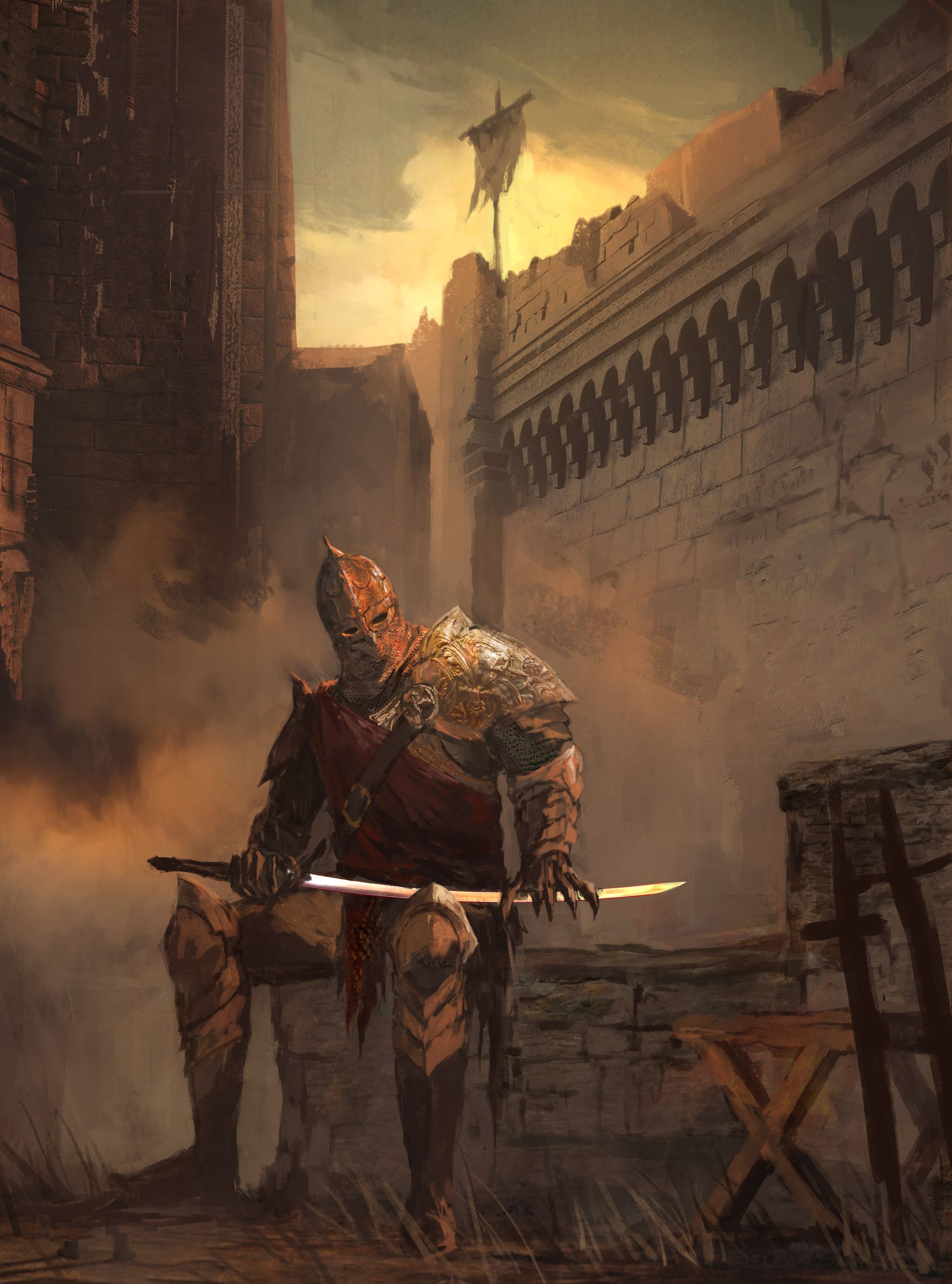
This is a beautiful piece of artwork for the Muzeiiyd Mercenary class by the extremely talented Shimhaq, who has done a number of pieces for the game. A good reference is half of the battle when it comes to 3d modelling, though I'm more used to working with blueprints of mechanical parts in a perfect perspective-less profile projection. Unfortunately, for me that is, the character is a human, which means they have things like limbs and hands and proportions which are only open to interpretation to a fairly limited degree. Seriously, what even are hands? They're likely tiny assymetrical monsters stapled to the end of what are otherwise perfectly simple appendages.
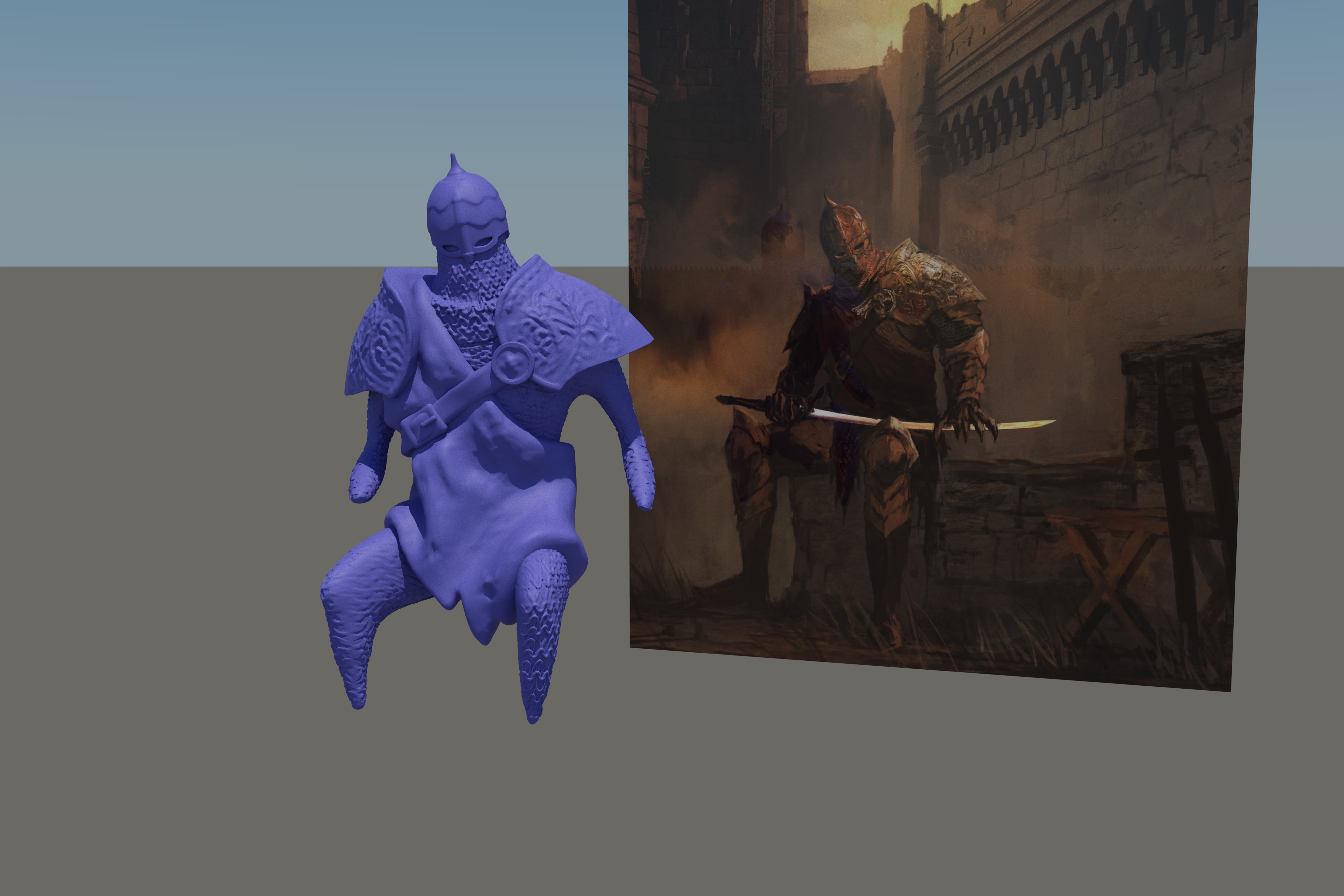
The first thing to decide on was the pose. Did I want to adapt the artwork faithfully or change anything? In this case, it was a fairly hard choice. The character is sitting - not the most dynamic pose. Would it make sense to have a miniature of a sitting character complete with a bench or section of masonry that moves around with them? Probably not. However, I decided to stay faithful. In part because it's easier, but also because it makes for a nice display when comparing the finished miniature to the artwork which inspired it.
I block out the basic pose and proportions, not worrying about complex or problematic details like hands. One of the challenges of making a miniature for 3d printing compared to traditional digital use is that it has to ultimately be a single watertight shell (or composed of multiple watertight, non-intersecting shells that can be glued together). To do this, you have to plan ahead very carefully and meticulously join parts without intersection. Or you save three times and then use the boolean tool while crossing your fingers. I'm not going to say you should do the latter, but if you do I won't tell anyone.
So, these days, there is a vast richness of excellent software with native 3d sculpting tools. Or, more specifically, there's Blender - which is a vast richness compared to the early days where it was basically just the demo version of Zbrush and we all thought that it was neat but had no practical applications (because games didn't use bump or normal maps back then and baking was a thing you did to cakes). I, of course, stubborn and oldschool as I am, do not use Blender because I have yet to decipher its arcane interface. Instead, I use 3dsmax, which has such wonderful and entirely intuitive and logical features as four separate boolean tools, at least one of which is almost certain to crash the program the moment it has to do anything more complicated than join two intersecting cubes.
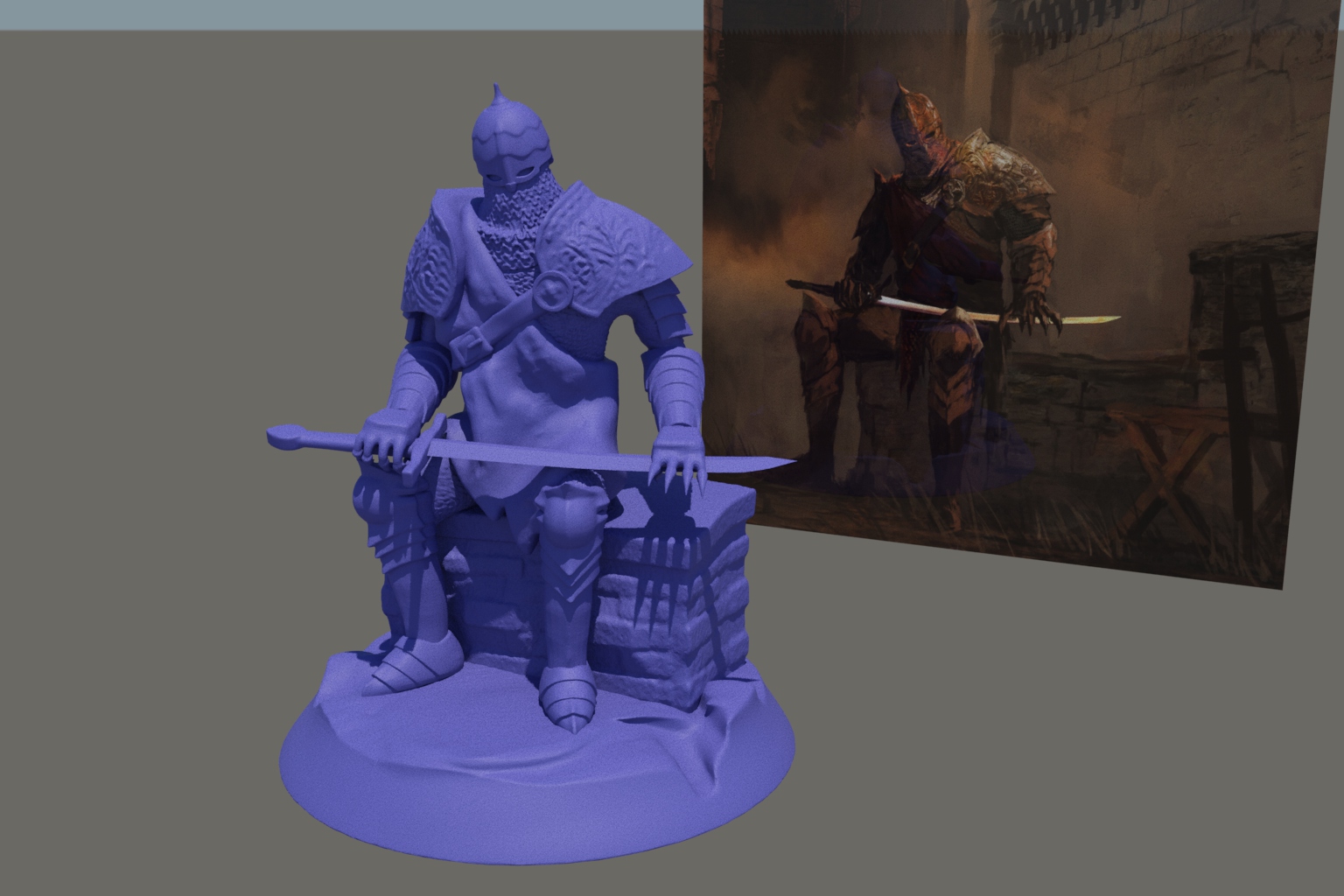
I appreciated that jumping to the end result of the 3d modelling process is not overly helpful for teaching you how to make miniatures or walking through the process of how I did it, but I think the real message here is: 'if you want to do this, don't do it the way I do, just go and learn blender and sculpt it properly like a sane and competent artist'. Anyway, eventually I've gotten things to a fairly completed state that I'm happy with and you can see that the end result is looking pretty close to the artwork. One thing to keep in mind though when making miniatures is that proportions often have to be adjusted and you need to thicken up anything which would be too thin or flimsy. If you were to take 'human' miniatures from any popular tabletop game (I don't know why I worded that like saying 'Warhammer' is illegal) and scale them up to human size, you would see that they have limbs like tree trunks and heads the size of beachballs. Personally, I prefer more realistic proportions, so I tend to compromise by only thickening up the really flimsy parts (like the sword blade in this case) and then scaling the model slightly larger than the typical 28/32mm wargaming scale.
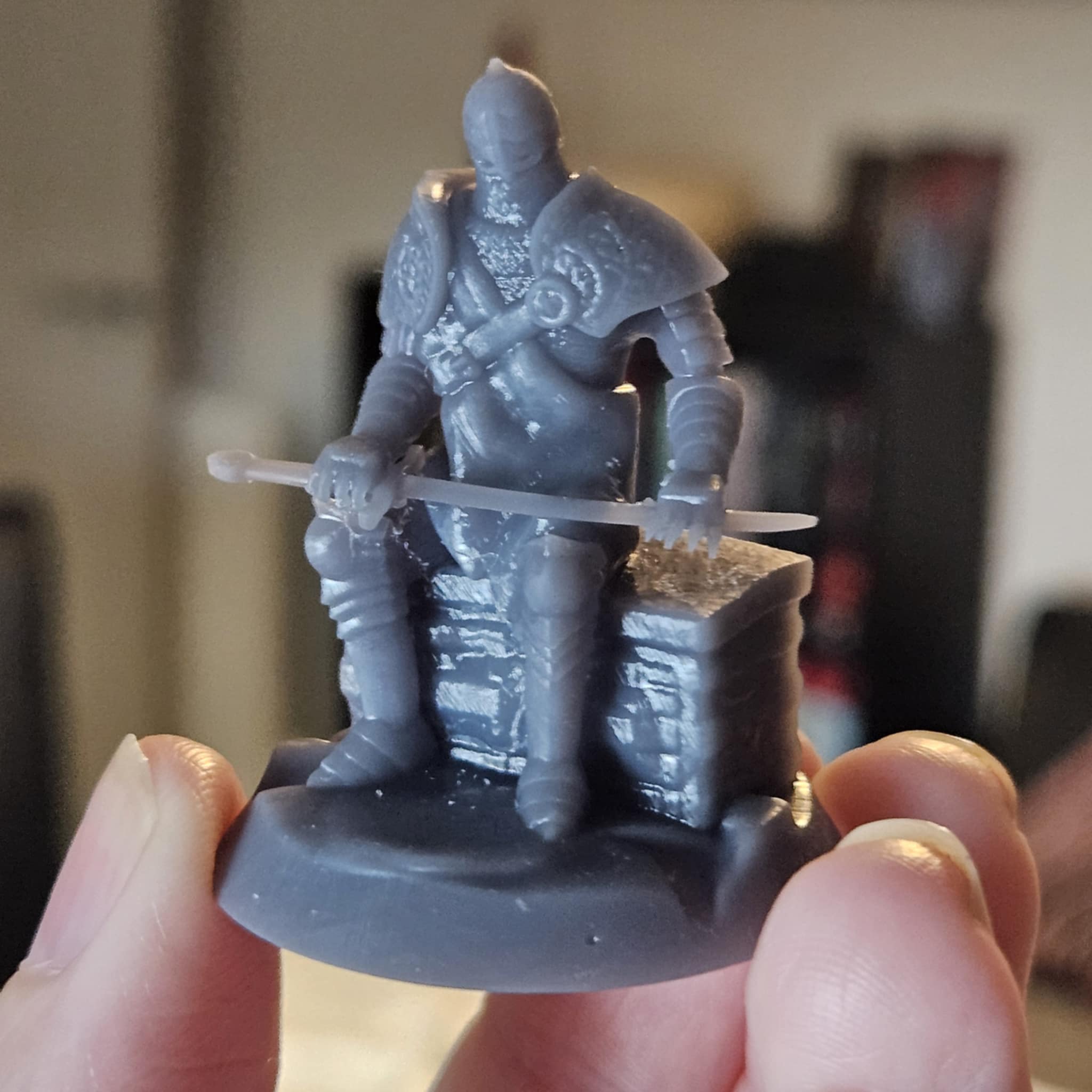
And here we have a cured late night test print with all of the support material removed. I use an Anycubic Photon M5s Pro to do my printing and AnycubicPhotonWorkshop to do supports and slicing. I find that the automatically generated supports are usually good enough with a few minor setting adjustments, but the real trick is finding the optimum orientation for the model. It is rarely ever correct to just position the model flat on its base for printing. The optimum orientation is different for every model, but nearly anything will benefit from some kind of compound angle. You need to think about how the print will build up in layers. For example, in this case, the sword is almost horizontal and has empty space under it. If you tried to print it like this, it would need a huge amount of support material between the legs, base and sword to print it correctly, which would end up leaving a lot of visible marks on the model. Rotating the model so that the sword is at an angle helps to avoid this, as fewer supports are needed.
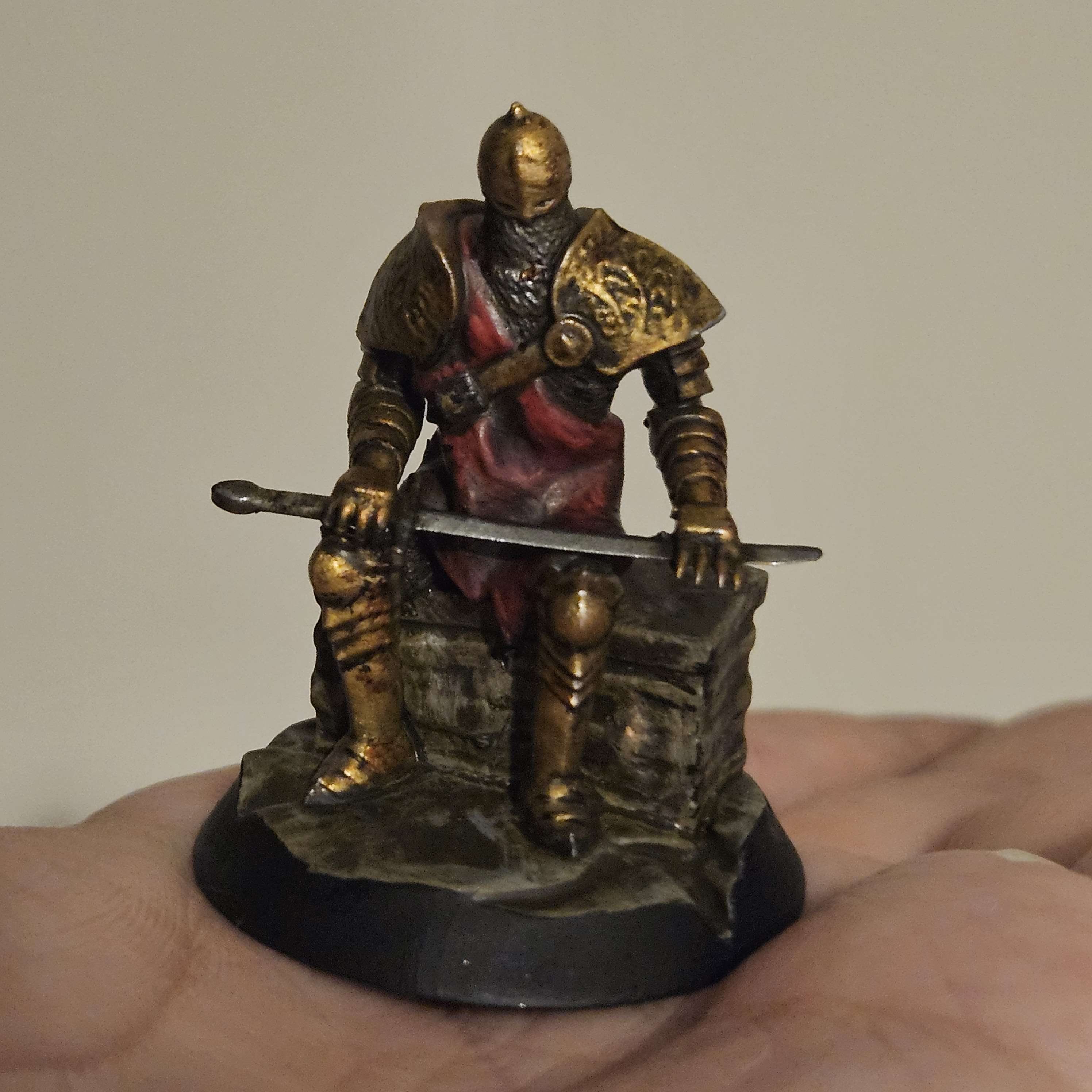
And this is my quick and dirty paint scheme of the finished test print. I base coated it black with a white highlight from above (this is a painting technique called zenithal which is particularly effective when using quite transparent layer paints) and then slowly built up the main areas of colour. A dark brown oil wash was used to shade all of the recesses and bring the overall colour palette colour together. Oil and enamel washes are really like magic compared to traditional acrylic washes because they don't leave tide marks and you can work them back subtractively from raised areas using a cotton bud or an old sacrificial brush. I added a little bit of weathering and some highlights on top after the wash had dried.
So, what do you think? Did I manage to capture the look of the character from its rulebook artwork? Are miniatures something that you care about when it comes to tabletop games? Join me next time for another prosaic stream of consciousness where I use far too many words to mostly avoid talking about the thing that I said I would talk about.
Get You Will Die In This Place (development preview)
You Will Die In This Place (development preview)
A nihilistic dungeon crawler about death, art and identity.
| Status | In development |
| Category | Physical game |
| Author | Liz |
| Tags | Atmospheric, Creepy, Dark Fantasy, Dungeon Crawler, Horror, Narrative, Psychological Horror, Survival Horror, Tabletop, Tabletop role-playing game |
More posts
- Announcement - Selected for Gamefound RPG PartyJun 11, 2025
- Translating Narrative Themes Into Mechanics - Character Classes (part 1)May 15, 2025
- Major Update - New Preview AvailableMay 11, 2025
- The Process of Building DungeonsMay 10, 2025
- The Cost of Art (And Maximising Value)May 07, 2025
- The Transient Nature of IdeasMay 06, 2025
Leave a comment
Log in with itch.io to leave a comment.